Church Lighting
Mark Sutton Vane
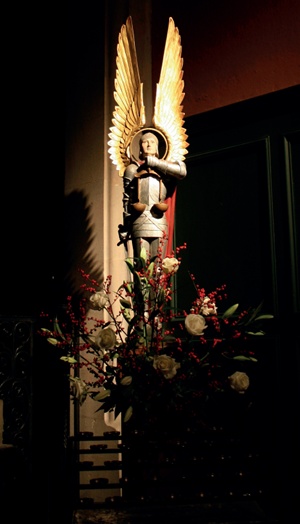 |
|
| Spot-lit statue of St Michael at the Church of St Michael and All Angels, Chiswick (All photos: Sutton Vane Associates unless otherwise stated) |
Lighting historic churches poses many challenges. At times, much of the light is natural daylight, which is both perfect in quality and free. However, in a typical church there will be places where natural light does not penetrate well, particularly where stained glass predominates. Even on a bright sunny day, daylight must often be supplemented by artificial light, but without negating the benefits of available natural light.
As dusk approaches, the use of artificial light will need to be extended to suit the various functions and activities taking place. Controlling the varying lighting requirements can be complex. This article outlines the use of artificial light in historic places of worship and how it can be controlled.
Church lighting has a number of requirements, some practical, some aesthetic. First there needs to be enough light to move around safely and comfortably so that, for example, steps or obstructions are clearly visible at all times. There also has to be enough light for church users to carry out activities comfortably, from reading the small type in a hymn book to watching the minister or reader, or following a performance.
The church may have fine architecture or furnishings that can also be accentuated. The human eye is drawn to the brightest object in the field of vision so spot-lighting can be used to pick out a crucifix, organ or other significant feature. By using light in this way it is possible for the people running the church to highlight some features and exclude others, changing the atmosphere and character of the space.
Churches are increasingly being used for a wide range of activities, including concerts, talks, meetings, art exhibitions and children’s activities. For some events the building may be full to capacity, while others might be confined to a small gathering in a side chapel. The lighting must be right for each activity so it needs to be flexible. However, this can result in a huge array of switches in even a small church or chapel, making it difficult to control.
Making a scheme flexible in a user-friendly way requires skill and an understanding of the specific requirements of the church. The first step in the design process, therefore, is to explore the requirements with the client as fully as possible. Then the resources must be established – usually the funds and time available. Finally, the design is created that matches the requirements to the resources.
A large parish church will have several spaces with different requirements. For example, when the church is open to visitors on a gloomy winter day, a low level of light might be provided in the aisles, while a higher level might be used for a side chapel witha fine altar. It may be that the choir is only present in the choir stalls during some services, so it makes sense to light the stalls only at these times and to let them be less visible when empty. At times the west end and the area around the font may be the centre of an event, while at others it may be the chancel.
If performances are regularly held in front of the chancel, then the lighting installed in this area can be used to create a concert-hall atmosphere. The seating area needs to be brightly lit while the audience members find their seats, but the performance area may be dimly lit to give a feeling of expectation. When the performance starts the ‘house’ lighting is dimmed down and the lighting on the stage brought up to focus attention on the performers. In order to do this two things are needed: dimmable lighting and a control system which manages the performance area separately from the rest of the interior.
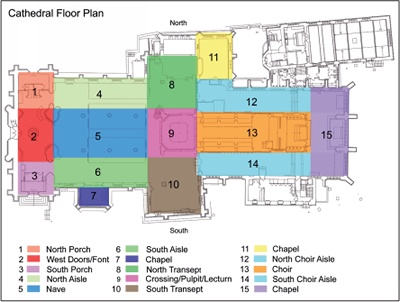 |
||
| Typical arrangement of spaces in a small cathedral (Newcastle), each of which may be considered a separate lighting zone. Steps may be considered as specific hazards in the circulation areas which run through the zones. |
It is these two fundamentals, dimming and independent control of each area, that create flexibility. By being able to raise or lower the brightness of the lighting in different areas it becomes possible to set up different lighting scenes for different needs.
To light a specific area, the light must be contained and prevented from flooding out into other areas. If bright modern lights are used they should generally have narrow beams so that they only light a specific area. It is easier to reduce glare by using fittings with a narrower beam. This principle also applies to the light from decorative fittings: it is best if the light is directed at welldefined areas and does not produce glare.
The lighting for areas which will be used by churchgoers and other visitors should be more or less vertical to avoid glare. Lighting that is directed vertically downwards also feels natural and comfortable. However, the lighting of the building can shine at whatever angle is appropriate, and there will be occasions where even floor-level uplighting can be achieved without glare.
Whatever angle is chosen, a decision must be taken about the visibility of the fittings. In a historic church it is generally best to conceal non-decorative fittings. If there is nowhere suitable to hide them, it is important to consider their appearance and the visual impact on the church interior. It may be possible to adapt existing historic fittings to incorporate small spotlights, or new decorative fittings may be introduced that are sympathetic to the historic space.
CONTROLS
It is essential that the dimming is easy to use. Lighting controls come in a bewildering range of different types. The best way to achieve a user-friendly control system is to consult those who will be using the system regularly.
A simple button control system is often the best choice. Pressing one button calls up the lighting for a Sunday service, another for a small service in a chapel, the next for a concert and so on. This type of control is called scene setting, as each button activates a pre-programmed lighting scene (the concept, and hence the name, comes from the theatre).
It is possible to have more than one control panel so that lighting scenes can be activated or adjusted from different parts of the church. For example, some lighting could be controlled from a panel at the entrance and some from a second panel in the chancel, thus avoiding a bewildering array of options. A remote control can also be added to the system. One priest likes to add a little theatre to his services by subtly raising the brightness of the light on the altar area at appropriate times using a remote control hidden in his pocket.
Some places of worship have a scene set control system that is not altered after it has been installed and set up. Others like to change the scenes and modify them as the uses of the spaces change. Depending on the type of control system, modifying lighting scenes can require some technical ability. Some churches may have staff or volunteers who particularly enjoy getting their hands on an iPad and setting up a lighting scene for a special event. It’s always important that the control system matches the needs and capabilities of the place of worship and its staff, both now and in the future.
Alternatively, the lighting can be controlled by dimmer knobs or sliders. This means that the levels have to be set each time the lights are used, but this system is intuitive, cheaper and completely flexible.
LEDs
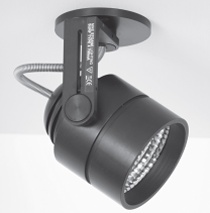 |
|
| Modern narrow-beam light fitting used at the University Church of St Mary the Virgin, Oxford: the unit is just 100mm long by 115mm high (Photo: Mike Stoane Lighting) |
Recently, lighting has been revolutionised by improvements in light emitting diodes (LEDs). These fittings have a number of advantages. LED lamps can last for up to 50,000 hours. If they are used for 40 hours each week they should last for around 20 years. Furthermore, LEDs use less electricity than conventional light sources so they save energy. They can also be dimmed very well and are generally smaller than other types of light source.
However, they do have a major disadvantage: although there are many cheap, poor quality LED fittings on the market, good quality LED fittings are expensive. It is essential to use only fittings from known, reliable manufacturers. The extra cost of good quality fittings is off-set by their longer lifespan. The savings in maintenance and energy make LED light fittings the favourite choice for many churches.
Because good quality LED lamps last so long, they can be installed in less accessible, and therefore less visible, locations. It is now possible to have light fittings hidden high up among the ceiling rafters. The fittings can be maintained when the church is redecorated or when high level repairs or inspections are carried out.
LIGHT QUALITY
Like fluorescent tubes and other energy-saving light sources, different LEDs produce light in different shades of white, and quality may vary considerably. Selecting the wrong type may result in a very unnatural effect, so quality is just as important as brightness. Light quality is defined by two measures: colour temperature and colour rendering.
Colour temperature Light can be a cool, bluish white or it can be a warm white like a domestic tungsten lamp, or anywhere in between. The colour is precisely defined by a colour temperature rating. This is a non-intuitive number – the higher the temperature, the cooler the light appears.
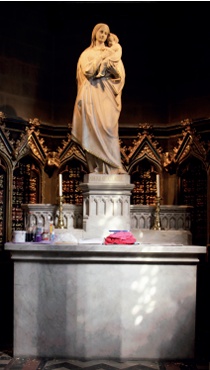 |
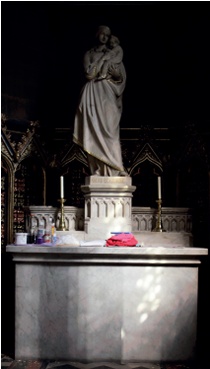 |
|||
| A statue at the cathedral church of St Marie, Sheffield with and without spot lighting | ||||
Colour temperature is measured in degrees Kelvin (K). A warm domestic light is 2,700k, while a cool, bluish white would be around 4,000k. If the light from a fitting is only described as, for example, ‘warm white’, this could mean anything and this type of fitting should be avoided.
As a rough guide, 3,000k is a good compromise colour temperature for most church buildings.
Colour rendering The other measure of the quality of light is the Colour Rendering Index (CRI). This is a measure of how accurately the light can render colours using a scale of 0 to 100. The higher the number, the better the light source’s colour rendering accuracy.
A modern, good quality light for church use should have a CRI of 90 or above. Unfortunately, fittings with higher colour rendering tend to be more expensive and less efficient at converting electricity into light. The only advantages of old-fashioned tungsten filament lamps were that they had a fixed CRI of 100 – the highest possible – and the limited choice of colour temperature made choosing fittings much simpler.
In view of the current trend towards broadening the function of historic churches to suit the needs of local communities, recent developments in lighting technology are invaluable. Many churches which have installed new flexible lighting systems are able to host a much wider range of events and activities than previously. Often only relatively modest changes to improve the functionality of their interiors can provide the key to securing their future.



